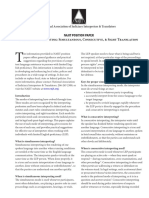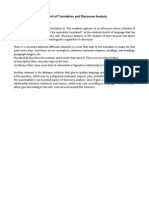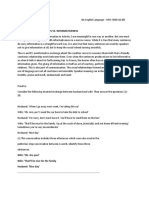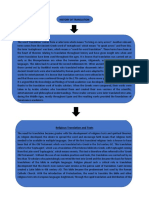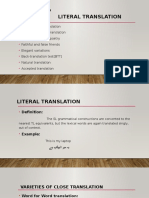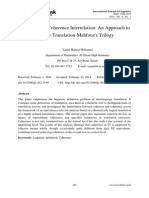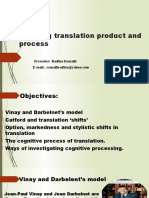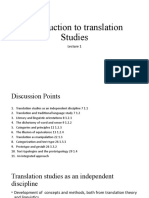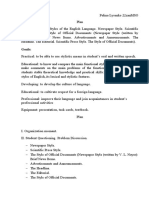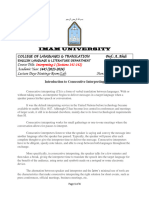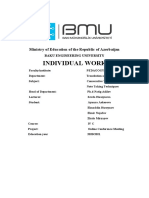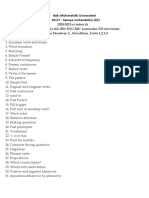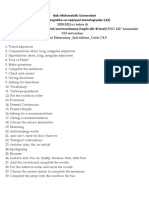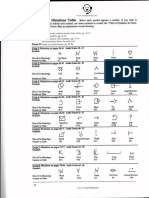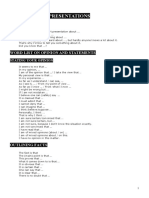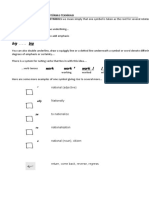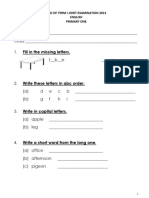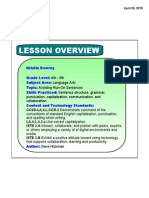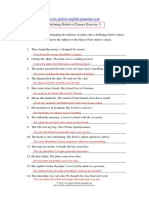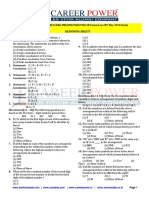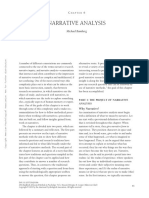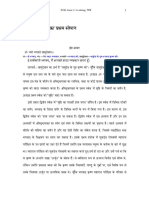Note Taking in Consecutive
Interpreting
1. Introduction
1. 1 What is Interpreting?
Interpretation occurs during cross-cultural communication when two interlocutors do not share a
language. By bridging the gap between languages, the interpreter helps speakers to discharge their
duty to make themselves understood and helps listeners to satisfy their need to understand what
is being said. The goal of interpretation is that a message makes the same impact on the target
audience that a speaker/signer intends for an audience of her/his same language. Communication
involves intention, context, form, gist, gesture, tone, relations of power, etc. The different
situations where interpretation takes place make very different demands of the interpreter.
Interpretation requires superior language ability in at least two languages. It also requires the
ability to accurately express information in the target language. Besides deep knowledge of both
languages, it is crucial that an interpreter also understands the subject matter of the text or speech
he is interpreting. Interpretation is not a matter of substituting words in one language for words in
another. It is a matter of understanding the thought expressed in one language and then
explaining it using the resources and cultural nuances of another language, so they can express the
source text or speech so that it sounds natural in the target language. The interpreter relies mainly
on the ability to get the gist of the message across to the target audience on the spot as an
interpreter is expected to convey the essence of the message immediately in satisfactory
paraphrase or a rough equivalent in order not to keep the audience waiting.
1.2 Modes of Interpreting
According to Hatim and Mason (1997: 36), there are three principal modes of interpreting:
simultaneous, consecutive.Those are inevitably place different demands on the interpreter
a. Simultaneous
This mode is considered a harder mode of interpreting and involves the interpreter continuously
interpreting from the source language into the target language as the source speaker is speaking.
Simultaneous interpreting is rendering an interpretation continuously at the same time someone is
speaking. Simultaneous interpreting is intended to be heard only by the person receiving the
interpretation and is usually accomplished by speaking in whispered tones or using equipment
specially designed for the purpose in order to be as unobtrusive as possible. It is usually used in a
conference or in a big seminar.
According to Seleskovitch (1978:125) in Mikkelson (1998), in simultaneous interpretation the
interpreter is isolated in a booth. He speaks at the same time as the speaker and therefore has no
need to memorize or jot down what is said. Moreover, the processes of analysis-comprehension
and of reconstruction-expression are telescoped. The interpreter works on the message bit by bit,
giving the portion he has understood while analyzing and assimilating the next idea.
Because of the short time frame and the complexity of language, a simultaneous interpreter must
be quick-thinking and decide on the most likely interpretation and follow it through. To spend
unnecessary time agonizing over the speaker`s phrasing could amount to losing important
information in the next sentence.
According to Hatim and Mason (1997 : 45), texture comes to the fore in simultaneous interpreting.
The term texture refers to various linguistic devices applied in a text with a purpose to build a
flow of sense and to make a sequence of sentence operational or what are said as cohesive and
coherence. In simultaneous interpreting, the interpreter should react and interact from one
utterance to other utterance where overlapping between various element of sequence is
unavoidable. It is impossible to get the whole structure nor the context of a text in simultaneous
interpreting, As an anticipating strategy, an interpreter should pay attention on the variety of
�cohesive devices used in the text as a reference as texture provides the interpreter with “a point of
departure” that enable him to be able to follow the sequence or the flow of the text
b. Consecutive
Unlike the simultaneous interpreting where the interpreter has at least something to embark upon,
the consecutive interpreter has to wait before he/she can deliver the output text. It means that it
will add pressure and extra load on memory, which results that information related to texture and
context become rather too detail to hold.
According to Hatim and Mason (1997: 42), consecutive interpreter, whose output comes after the
source text has been delivered, tends to focus on information relevant to text structure. Effective
consecutive output thus exhibits a clear outline of the way the text is structured.
Further discussion about consecutive interpreting will be presented on the next section
2. CONSECUTIVE INTERPRETING
As what has been stated in the previous section, consecutive interpretation is a mode in which the
interpreter begins their interpretation of a complete message after the speaker has stopped
producing the source utterance. At the time that the interpretation is rendered the interpreter is
the only person in the communication environment who is producing a message. Good memory
is a prerequisite of good interpreting. Memory in consecutive interpreting refers to the capacity for
storing and retrieving information of the interpreter. Many people say that although they can
understand the message the speaker is delivering, they find it difficult to commite content of the
message to their memory. As a result, it is impossible for them to interpret what has no longer
been retained in their mind into a different language. Then the major problem here is how to
supplement the memory for consecutive interpreting. And the solution to the problem is to
acquire note-taking skill. Notes can serve as an effective aid to the memory of the interpreter but
they can never replace the role of memory. A basic principle for successful consecutive
interpreting is that memory comes first and notes function to support it. Target language
reproduction should not be based on notes only but on the combination of memory and notes.
2.1 Consecutive Interpreting As A Cognitive Process
In order to be able to interpret a text the interpreter must be able to receive and understand the
incoming message and then express its meaning in the target language. In order to accomplish
this task, the interpreter must go through an overlapping series of cognitive processing activities.
These include: attending to the message, concentrating on the task at hand, remembering the
message, comprehending the meaning of the message, analyzing the message for meaning,
visualizing the message nonverbally, and finally reformulating the message in the target language
Seleskovitch, among others, points out that there is another practical reason for the interpreter to
discard the form of the source text, there is only so much that a person can hold in their short-term
memory. As the interpreter receives the source text the information passes initially through their
short-term memory. If the interpreter does not do anything with this information it will soon
disappear. Smith (1985 : 38) notes that, “Short term memory has a very limited duration. We can
remember six or seven items only as long as we give all of our attention to them”. If an interpreter
attempts to retain the form of a source utterance their short-term memory will be quickly filled
with individual lexical items, which may not even compose a full sentence.
It is because of the limitations of short-term memory that interpreters are required to drop form
and concentrate on meaning. Both Seleskovitch and Smith propose that meaningful segments of
great size can be placed into long-term memory and retrieved later. Of course a chunk of
information must be understood in order to be meaningful.
Due to the greater ease of assimilating larger meaningful chunks of information it force the
interpreter to focus their attention on these larger chunks. A larger chunk of text will usually
�contain a greater amount of meaning. This relationship will help the interpreter to understand the
source text when working consecutively
Interpreters are not charged with merely understanding the message, they must also be able to
remember it, in order to deliver their interpretation. Seleskovitch notes that dropping form aids
the interpreter’s memory because they are not concentrating on remembering the words, or even
the structure of the source text. Instead, the interpreter understands the message, connects it to
long-term memory, and is then able to reformulate it in much the same way the moviegoer can
relate the points of a film. To this end interpreters working consecutively will often make notes as
they take in the source utterance. These notes help the interpreter retrieve the message from their
long-term memory and consist of, “symbols, arrows, and a key word here or there” (Seleskovitch,
1991 : 7). These few notes are effective because interpreters do not produce their target texts based
on the form used by the speaker but on what they understood of the meaning of the source text.
The “key words” may consist of words that will remind the interpreter of the speaker’s point, or of
specific information “such as proper names, headings and certain numbers” (Seleskovitch, 1978 :
36). Taking note in consecutive interpreting will be discussed further in the next Section.
Wei HeZhong, in the article Memory Training in Interpreting views consecutive interpreting as a
process consisting of two separable phases. The first phase is listening during which the
interpreter listens to the sourcelanguage speech and takes notes; the second phase is
reformulating, during which the interpreter reproduce a target-language speech from memory
and from notes.
1. a. Phase One- Listening Phase:
CI = L (listening) + M (short-term memory) + N (note-taking)
In this phase, the interpreter is required to listen attentively, selectively and actively to the original
speech, then the interpreter’s short-term memory is used to store the messages that have been
heard to put them either in memory or in notes or both. It is easy to recognize that note-taking is
an undivided part of the first phase.
1. b. Phase Two- Reformulation Phase:
CI = R (remember) + R (read the notes) + P (produce the speech in the target language)
In the second phase, the interpreter retrieves messages from their memory as well as from the
notes, and produces the speech in the target language.
2.2. Skills Requirement in Consecutive Interpreting
According to Jones (2002: 5-6), a consecutive interpreter “listens to the totally of a speaker’s comment,
or at least a significant passage, and then reconstitutes the speech with the help ofnotes taking while
listening; the interpreter is thus speaking consecutively to the original speaker, hence the name”. Thus,
there are three main skills that have to be mastered by a good consecutive interpreter i.e. :
1. Listening Skill
As what has been explained before, Listening Phase is the first phase to do in consecutive
interpreting. Listening is an activity of paying attention to what speaker say and trying to work
out what they mean. Listening requires full focus, engagement, involvement and comprehension.
If comprehension is incomplete, interpreting will not be complete either, it will not be a success
interpreting as comprehension of the entire meaning is the first condition of interpreting.
1. Note Taking
According to Jones (2002 : 39), note-taking is part of the whole process of consecutive interpreting
including: understanding, analysis and re-expression, and if these activities “are not done correctly,
the best notes in the world will not make a good interpreter”. In this case, the interpreter may only write
down individual words which are put together forming a meaningless chunk of information. And
if note-taking is separated from the activity of analyzing the speech, the interpreter may be lost in
�the information overload. The interpreter cannot identify what are the main ideas, what are the
secondary elements, and what are the connections between them in order to decide what should
be noted and what should not. Inevitably the notes become nothing more than a mess, which will
definitely push the interpreter in a very difficult situation later. When looking back notes, the
interpreter cannot have a clear review of the speech content. And this obviously goes against one
of the basic functions of notes.Note taking will be discussed further on the next Section.
1. Speaking
The importance of this final phase of interpreting resides in the fact that it leads directly to the
final product of the process, i.e. the target speech. It is this speech that reflects the outcome of the
first two phases of the process and shows whether they have been carried out appropriately or
not.
When producing the target text, the interpreter must display the utmost fluency as if he were
expressing his own ideas naturally and spontaneously in the TL. Over and above this knowledge
of TL words, expressions and formulaic transfers, the interpreter must possess textual competence
in this language, he must be able to produce texts. Incomplete sentences which do not make sense,
and likewise complete sentences which are totally disconnected and isolated from one another, do
not serve the purpose of interpreting.
3. NOTE TAKING, AN IMPORTANT SKILL TO BE MASTERED
Note taking has been proved to be very useful for the interpreter working consecutively. Firstly,
notes improve concentration; prevent distraction, thus facilitating the reception and analysis of the
speech. Secondly, notes help the interpreter relieve the memory. Although the interpreter may
have understood the ideas of a speech, he or she cannot remember every point in the speech
because one characteristic of short-term memory is that it only keeps information for a limited
amount of time, cognitive scientists also show that for nearly all speakers of all languages, list
retention peaks at around seven items, plus or minus two. By recording the specific details and
data such as proper names, numbers, figures, lists of things, or specialized terms, technical
expressions, etc, notes release the interpreter from bearing the whole thing in mind. Thirdly, notes
activate the memory of the interpreter with cues or signals that call up the information in the
speech. With notes, the main ideas, the secondary elements and the links among them become
clear and easier for the interpreter to visualize. Finally, notes can also be used to highlight missing
details, inconsistencies within the speech and anything implausible that needs attention latter.
Obviously, the skill of note-taking is very helpful to interpreters, the content and structure of a
speech are reflected in notes, and the notes in turn are used as a path to verbalize the speech. Thus
notes play an important part in consecutive interpreting. However, taking proper notes needs a lot
of practice, and the gap between the “theory of note-taking” and “actual notes” can be very large.
In order to bridge the gap, first, an understanding of note-taking process is required.
According to Hanh (2006), the process of note-taking is not a simple one. In order to make notes
become an aid to enhance consecutive interpreting, the interpreter must answer the three basic
questions as follows: (i) what to note; (ii) how to note; and (iii) when to note.
(i) What to note
1. Main Idea
Notes can be considered as the frame outline of the speech shaped with main ideas and the
links between them. It is crucial for an interpreter to have the ability to identify, select and retain
important ideas and omit anything which is not relevant to the understanding of the original
speech. Moreover, the interpreter can easily trace back the structure of the speech; hardly misses
out important ideas; and always keeps fidelity to the original content by recording the main ideas
in notes.
�2. Links Between Ideas
The links between ideas is the following thing the interpreter should consider in note taking. The
relations between individual ideas influence the overall meaning of the text. Thus it is obvious that
the interpreter should realize and render the such links. According to Jones in Hanh (2006), the
ways in which ideas may be linked together are :
(i) the logical consequence which is expressed clearly with words such asconsequently, as a
result, accordingly or therefore;
(ii) the logical cause which can be recognized with the words because, due to, as, orsince;
(iii) opposition which often goes with but, yet, however or nevertheless
1. Verb Tense
According to Jones, it is also important to note down tenses of verbs. That means “when noting
verbs, interpreters should thus take care to note the tense correctly, and if appropriate the mode, in
particular conditional”. The modes and tenses of verbs have decisive influence on the meaning of a
sentence.
(ii). How to Note
How to note is also very important. Obviously, notes that are clearly separated and logically
organized help the interpreter avoid all confusion when reading back notes. And notes using
abbreviations and symbols are very helpful in activating the most information with the least effort.
1. Abbreviation
To take notes quickly, the interpreter can use abbreviations. Additionally, abbreviations can also
help the interpreter in saving time spent on other activities in the process of interpreting. In order
for the interpreter to understand immediately when reading back notes, these abbreviations must
be definitive and unambiguous because under time pressure the interpreter has no chance to
reconsider the meaning of abbreviations.
According to Hanh (2006), there are many principles and rules for the use of abbreviations.The
following suggestions about creating abbreviations are based on the truth that the fewer strokes
are written; the more time can be saved.
- Write what is heard: The interpreter can write a word by recording its sound only.
For example: high- hi; know- no; free- fre; fee- fe; night- nite; etc.
- Drop medial vowels:
For example: build- bld; legal- lgl; bulletin- bltn; save- sv; budget- bjt etc.
- Write initial and final vowels:
For example: office- ofs; easy- ez; follow- flo; value- vlu; open- opn; etc
Abbreviation of common international organization should be remembered by the interpreter. The
interpreter must have some background knowledge about it. The following are some common
names in abbreviation :
World Bank WB
European Union EU
Asian Development Bank ADB
World Trade Organization WTO
World Health Organization WHO
International Monetary Fund IMF
United Nations Children’s Fund UNICEF
North Atlantic Treaty Organization NATO
Food and Agriculture Organization FAO
Asia-Pacific Economic Cooperation APEC
�b. Symbols
A symbol is something such as an object, picture, written word, sound, or particular mark that
represents something else by association, resemblance, or convention. Symbols are quicker and
easier to write than words. Similar to abbreviations, firstly symbols need to be prepared in
advance. Any symbol improvised in the middle of interpretation could drive the interpreter into a
difficult and intense situation. One basic rule for the interpreter: only use the symbols which are
already stuck in the mind. Secondly, symbols must be consistent. That means symbols are
instantly associated for the interpreter himself with the meaning he gives them. Attending to this
point, the interpreter can avoid mistakenly “deciphering” the meaning of the symbols he or she
uses.
Followings are some symbol examples retrieved from electronic source at Interpreter Training
Resource.
The most important of all, abbreviation must be well understood by the member of interpreter’s
group.
(iii) When to Note
An interpreter should know when to take notes.It is a very important and also tough decision that
requires the interpreter to arrive at properly and wisely. Interpreters should start the notes as soon
as possible without having to wait for a complete “unit of meaning”. Therefore, when the
interpreter can sense the meaning of a sentence which might has not been completed, he or she
should note it down. Here the interpreter has the ability to “forecast” or “feel” upcoming things.
Besides the interpreter is not required to take everything exactly the same way as the speaker, his
or her notes are not presented in exact order as they were said by the speaker, so there is no need
for the interpreter to wait until the speaker finishes an utterance to take note. It is also worth
mentioning that as soon as speakers finish their utterance(s), the interpreter should stop taking
notes instantly and start reproducing ideas. If the interpreter is too preoccupied with notes, he or
she will delay the interpretation, which is not wanted. The interpreter cannot afford to take longer
than the speaker. He or she is expected to react immediately after the speaker has finished.
4. CONCLUSION
Interpreting is like a gap-bridge of language barrier in cross cultural communication.
The goal of interpretation is to convey a message that make the same impact on the target
audience that a speaker/signer intends for an audience of her/his same language. The different
situations where interpretation takes place make very different demands of the interpreter.
According to Hatim and Mason, there are three major modes of interpreting i.e. : (i) Simultaneous
Interpreting (ii) Consecutive Interpreting and (iii) Liaison Interpreting. Among the three modes,
consecutive interpreting is widely used both in formal and informal occasion. There are three basic
�skill requirements in consecutive interpreting namely Listening (Understanding), Note Taking
(Analysing) and Speaking (Re-Expressing). The skill that only occur in consecutive interpreting is
Note Taking. It is an importance skill to be mastered. In order to be able to take notes effectively,
an interpreter should have a comprehension on three basic requirements of note-taking as
follows : (i) what to note; (ii) how to note; and (iii) when to note

